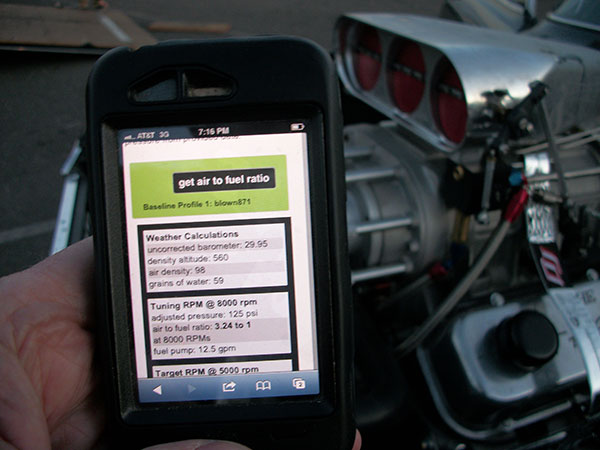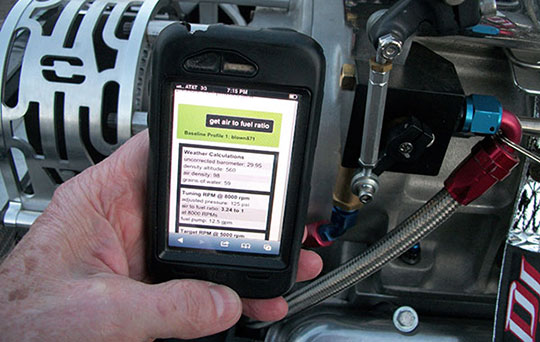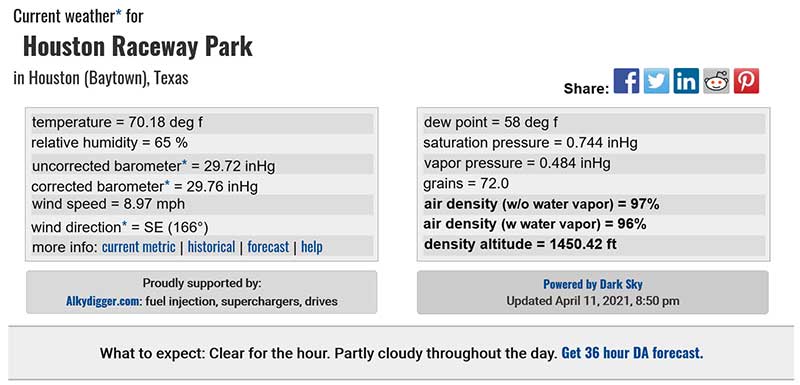Quickly Access Your Favorite Track
This article is an almost direct copy from our partner site at AirDensityOnline.com. We are planning on adding a feature for our users to be able to save their most visited tracks to their user dashboard. This is another option for users who wish to access a direct link from their phone's home screen.
Note: this applies to iPhones only. However, there is a similar task for Android devices as well. See the links at the bottom of this article.

Figure 1
Did you know you can save a quick link to the weather on your favorite track on your iPhone's home page? It's pretty easy but you have to know where to look. Follow these steps.
Read the rest of this article »
Fuel Injection High Speed Bypass for NA Engines
The high speed bypass is often used in a fuel injection setup.
NORMALLY ASPIRATED ENGINES
The high speed leans out the engine as the RPM go up and the volumetric efficiency goes down.
The VE is often near 100% at the torque peak.
The air flow per revolution is max.
A typical norm asp engine cammed up for racing may see a torque peak around 5,000 RPM.
Tuning should be with the main bypass for max power up to the torque peak or just beyond.
We often recommend an AFR of 4.8 to 1 for methanol fuel for the torque peak.
Read the rest of this article »
We are live!
Welcome to our new site! If you are here from Air Density Online, we're glad to have you!
All links on Air Density Online should now redirect here. We have worked to make this transition as smooth as possible but there may be some hiccups. If you have any issues or if you wish to send any feedback, let us know.
Engine Tuning Using the Main Bypass

When you’re thrashing in the pits getting ready for the next run, a quick way to update your jetting is to adjust the main bypass while leaving the rest of the jets alone. If you have a really well dialed-in jetting combination with good fuel system pressure, this form of tuning simply controls how much fuel is going to the engine and how much is being diverted back to the fuel tank.
Tuning Steps
The larger the main bypass jet, the more fuel is diverted away from the engine. This can sometimes feel counterintuitive.
Read the rest of this article »
Setting up a new fuel injection system
If you're thinking of buying a new fuel injection system there are a few things to note when getting it calibrated with your existing setup.
Most fuel injection systems are shipped with a small main bypass which makes the engine run rich. While some systems run richer than others out of the box, they all come precalibrated with their own jetting. In addition, most new systems will run at the higher rpm's with a fuel pressure between 50-150psi. That means that at lower rpm's, the fuel pressure can be so low that the engine runs sluggish. Read the rest of this article »
Tuning with methanol vs nitro

The basics of engine tuning involve finding the right ratio of fuel mixed with air to get the right amount of power out of your engine. When you have a familiar engine setup and always race with methanol, that task can become tried and true. When you add percentages of nitro, things suddenly get more complex. Following are some of the differences between nitro and methanol.
Read the rest of this article »
Using Air/Fuel Ratio

Updated October 4, 2024
This article is taken from our partner site at AirDensityOnline.com
On this site, we talk a lot about finding your ideal air/fuel ratio. It is the concept that our mechanical fuel injection jetting calculators are built on, and it is the concept used in electronic fuel injection in order to maintain a good fuel system setup. Understanding air/fuel ratio can be very helpful when setting up your fuel system. It can mean the difference between a successful run and a blown engine.
Read the rest of this article »
Measuring the Atmosphere Around a Track

Note: This article is taken from our partner site at AirDensityOnline.com. It provides information we think may be useful for users of both sites.
We provide a lot of weather information for each track with the assumption that racers know what each value means. If you need a brief crash course in how to interpret the information found on each track page, see the information below. As always, if you have any questions about this or any information found on this site, contact us.
The air around a race track
Imagine a cubic foot of air near the ground level at the race track. It may seem empty but there are molecules moving around within that area. Depending on various environmental factors, that cubic foot of air can contain oxygen, other elements such as nitrogen and carbon dioxide, moisture, and particles of pollution. Each of these vary depending on the location, elevation, and current weather environment.
We need oxygen for combustion in our engines. However, as we can see, the amount of oxygen in the atmosphere fluctuates. This is why, for instance, you might notice a great engine performance at certain times of day and bad performance at others. Tracking the weather can help us determine jetting changes in order to compensate for the changing atmosphere. Using the information we provide on the tracks pages of this site can help you do that.
This article will explain those variables. Hopefully it will help you to better understand the atmosphere and better tune your engine for optimum performance.
Read the rest of this article »
Historical Weather Data

Historical weather from Sacramento Raceway. Click on the image to view more historical weather for Sacramento Raceay.
Note that this article is taken from our partner site at AirDensityOnline.com. This information is useful for users of both sites.
We've gotten a few questions recently asking about historical weather data. We just added the option to view hourly weather including air density, density altitude, and grains for past dates!
Read the rest of this article »
WELCOME!
Welcome to our new site! If you're new to this site and our partner site, RaceCarBook.com, we're glad you're here. Our sites aim to provide information and tuning tips for racers and engine tuners in the motorsports world. Specifically, we provide information and tools for mechanical fuel injected racing.
If you're here from Air Density Online, this might look a little familiar to you. We hope so! We have kept the new site as similar to the old site as possible in order to make the transition as easy as we can. That being said, we plan on adding new features and making this more useful than the old site.
We will be officially moving all ProCalc & ProTune users over here at the end of this month. We will be in communication with those customers as we go. In the meantime, look around and don't hesitate to send us any questions or comments.







